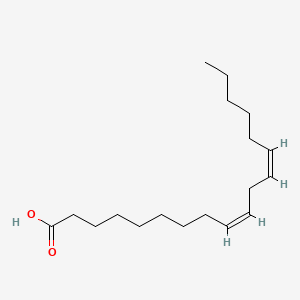Linoleic acid
Linoleic acid is a lipid of Fatty Acyls (FA) class. Linoleic acid is associated with abnormalities such as Diabetes Mellitus, Non-Insulin-Dependent, Metabolic syndrome, Obesity, Chronic Obstructive Airway Disease and Pneumonia. The involved functions are known as Insulin Resistance, Inflammation, Synthesis, Pathological accumulation of air in tissues and cytokine biosynthesis. The associated genes with Linoleic acid are TNF gene, CCL2 gene and TLR4 gene. The related lipids are palmitoleic acid, nervonic acid and Sphingolipids.
Cross Reference
Introduction
To understand associated biological information of Linoleic acid, we collected biological information of abnormalities, associated pathways, cellular/molecular locations, biological functions, related genes/proteins, lipids and common seen animal/experimental models with organized paragraphs from literatures.
What diseases are associated with Linoleic acid?
Linoleic acid is suspected in Obesity, Diabetes Mellitus, Non-Insulin-Dependent, Metabolic syndrome, Chronic Obstructive Airway Disease, Pneumonia and other diseases in descending order of the highest number of associated sentences.
Related references are mostly published in these journals:
| Disease | Cross reference | Weighted score | Related literature |
|---|
Possible diseases from mapped MeSH terms on references
We collected disease MeSH terms mapped to the references associated with Linoleic acid
PubChem Associated disorders and diseases
What pathways are associated with Linoleic acid
There are no associated biomedical information in the current reference collection.
PubChem Biomolecular Interactions and Pathways
Link to PubChem Biomolecular Interactions and PathwaysWhat cellular locations are associated with Linoleic acid?
There are no associated biomedical information in the current reference collection.
What functions are associated with Linoleic acid?
Related references are published most in these journals:
| Function | Cross reference | Weighted score | Related literatures |
|---|
What lipids are associated with Linoleic acid?
Related references are published most in these journals:
| Lipid concept | Cross reference | Weighted score | Related literatures |
|---|
What genes are associated with Linoleic acid?
Related references are published most in these journals:
| Gene | Cross reference | Weighted score | Related literatures |
|---|
What common seen animal models are associated with Linoleic acid?
There are no associated biomedical information in the current reference collection.
NCBI Entrez Crosslinks
All references with Linoleic acid
Download all related citations| Authors | Title | Published | Journal | PubMed Link |
|---|---|---|---|---|
| Liu F et al. | Simultaneous silencing of GhFAD2-1 and GhFATB enhances the quality of cottonseed oil with high oleic acid. | 2017 | J. Plant Physiol. | pmid:28644971 |
| De Weirdt R et al. | Mucosa-associated biohydrogenating microbes protect the simulated colon microbiome from stress associated with high concentrations of poly-unsaturated fat. | 2017 | Environ. Microbiol. | pmid:27883264 |
| Yuan H et al. | A network based covariance test for detecting multivariate eQTL in saccharomyces cerevisiae. | 2016 | BMC Syst Biol | pmid:26818242 |
| Matravadia S et al. | LA and ALA prevent glucose intolerance in obese male rats without reducing reactive lipid content, but cause tissue-specific changes in fatty acid composition. | 2016 | Am. J. Physiol. Regul. Integr. Comp. Physiol. | pmid:26764053 |
| Rosenblat M et al. | Nitro-Oleic Acid Reduces J774A.1 Macrophage Oxidative Status and Triglyceride Mass: Involvement of Paraoxonase2 and Triglyceride Metabolizing Enzymes. | 2016 | Lipids | pmid:27344666 |
| Abreu P et al. | Contractile function recovery in severely injured gastrocnemius muscle of rats treated with either oleic or linoleic acid. | 2016 | Exp. Physiol. | pmid:27579497 |
| Raimondi S et al. | Conjugated Linoleic Acid Production by Bifidobacteria: Screening, Kinetic, and Composition. | 2016 | Biomed Res Int | pmid:27429985 |
| Green D et al. | Central activation of TRPV1 and TRPA1 by novel endogenous agonists contributes to mechanical allodynia and thermal hyperalgesia after burn injury. | 2016 | Mol Pain | pmid:27411353 |
| Castrejón-Tellez V et al. | The Effect of Resveratrol and Quercetin Treatment on PPAR Mediated Uncoupling Protein (UCP-) 1, 2, and 3 Expression in Visceral White Adipose Tissue from Metabolic Syndrome Rats. | 2016 | Int J Mol Sci | pmid:27399675 |
| Wang S et al. | Linoleic acid and stearic acid elicit opposite effects on AgRP expression and secretion via TLR4-dependent signaling pathways in immortalized hypothalamic N38 cells. | 2016 | Biochem. Biophys. Res. Commun. | pmid:26879142 |
